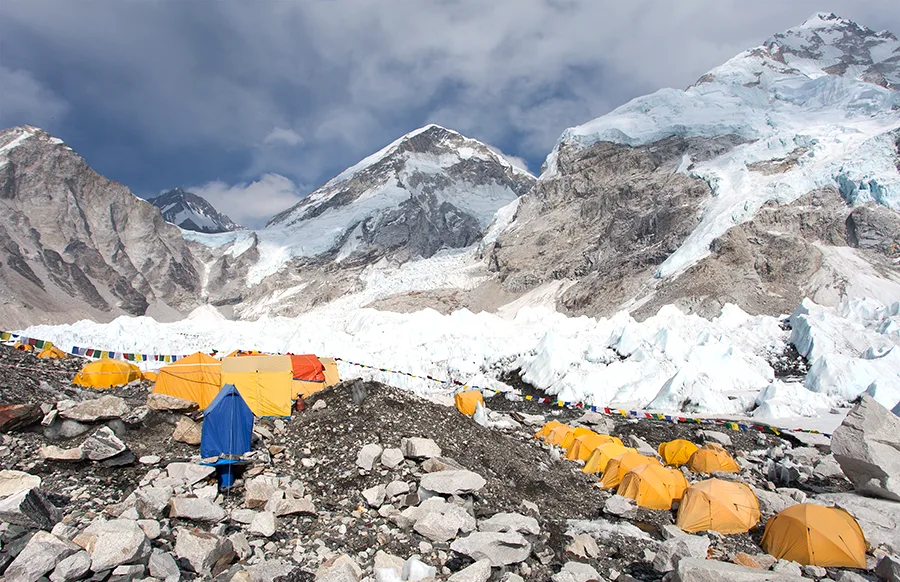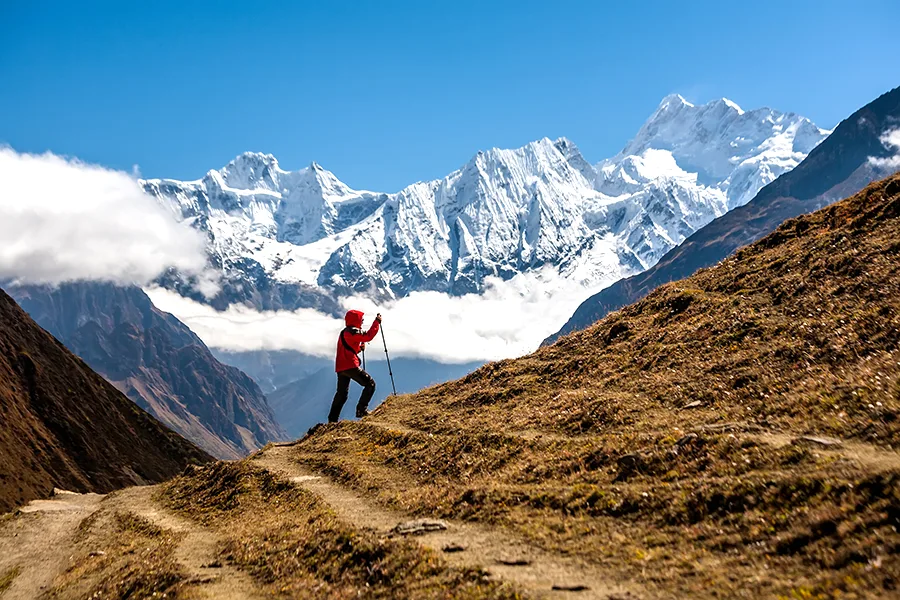Nepal Tea House Trek – A Complete Guide
Getting ready for a tea house trek in Nepal is like heading on the adventure for a lifetime experience. You’ll get to see attention-seeking natural scenes, enjoy extraordinary cultures, and make memories you’ll never forget. Nepal Tea House Trek is special from regular tenting journeys because you get to stay in small teahouses in place of tents.

Whether you are hiking to the lowest of Mount Everest or exploring the Annapurna vicinity, the Nepal tea house trek provides a thrilling experience through several top stunning mountains in the world.
What is a tea house trek in Nepal?
Visiting a tea house trek in Nepal is like going on an adventure that takes you through stunning mountains and beautiful villages. Instead of staying in tents and camping, you live in small hotels referred to as tea houses along the way. These teahouses are relaxed places to loosen up, devour, and sleep on the tour.
Imagine waking as much through breathtaking views of snow-capped mountains and lush forests of colorful vegetation. During the tour, you meet friendly locals who run teahouses. You will be welcomed with smiles and mouth-watering meals, supplying you with a perception of their subculture and traditions.
One of the most pleasing facts about the Nepal tea house trek is that you don’t need to bring food and heavy equipment. You can enjoy the lovely landscapes of Nepal without crafting a tent or cooking. It’s an amazing way to discover the Himalayas whilst feeling the warm temperature and hospitality of the locals.
An Untold History of Tea House Trek in Nepal
The history of the tea house trek in Nepal is linked to the country’s geography, culture, and tourist needs. Before the Nepal Tea House Trek, trekkers had to camp in tents and carry their food and equipment, making it inaccessible to the Himalayan trails.
In 1964, Jimmy Roberts led his first trip to Nepal with Mountain Travel. At first, the trip was like a camping trip, supporting the needs of the group. This is similar to how people used to climb mountains.
Some tourists ventured into the mountains and lived in local houses. In the 1970s, when more people arrived to travel, these dwellings were converted into teahouses. In the 1980s, there were many tea houses in the main trekking areas of Nepal.
These teahouses provided lodging and food for travelers. They have become an integral part of the travel experience in Nepal. The Jimmy Roberts walk in 1964 started it all. From tenting or staying in tea houses, hiking in Nepal has changed a lot over time.
Trekkers can now live more comfortably alongside the paths, making the trekking journey easier and more enjoyable. The idea for the Nepal Tea House Trek came about when locals started providing shelter and special meals to hikers along popular walking trails. These accommodations were usually simple tea houses or inns, providing weary travelers with a place to rest and eat.
Over time, tourism in Nepal increased and teahouse infrastructure improved dramatically. Locals invested heavily in their accommodation to meet the needs of travelers, providing comfortable rooms, hot water, and a variety of food. This development has revolutionized travel in Nepal, making it more convenient and enjoyable for the general public.
Today, Nepal tea house treks are the most popular way to explore the Himalayas. Hikers can revel in the outstanding scenery and wealthy tradition of this place and revel in the comfort and convenience of staying at local tea houses along the way.
This unique mixture of journey and hospitality continues to attract tourists from all over the world to Nepal’s Himalayas.
Facilities you can get in the Nepal Tea House Trek? Get Ready for an amazing adventure!
Get ready for an extraordinary adventure in Nepal with Nepal Tea House Trek! You’ll hike through beautiful mountains and adorable villages, staying in cozy tea homes with at-ease bedding facilities.
Try on tasty Nepali dal bhat and different yummy dishes whilst speaking to new friends. Some tea houses have Wi-Fi and locations to charge your gadgets. Just remember to drink lots of water, be respectful, and be careful of altitude problems.
With proper plans and a love for the journey, your Nepal Tea House Trek might be an incredible journey you’ll never neglect!
1. Facilities at Tea Houses:
a. Accommodations: Tea houses provide primary accommodation facilities with beds, blankets, and pillows. Rooms are frequently simple and can be shared with different trekkers.
b. Dining Areas: Most tea houses have communal eating areas wherein trekkers can enjoy their food and socialize.
c. Common Areas: Some tea houses offer cozy common areas with seating preparations wherein trekkers can relax, read, or chat with fellow travelers.
d. Hot Showers: While not necessary it should be in all tea houses, some do offer warm bath facilities at a very affordable rate.
e. Charging Points: Charging facilities for digital gadgets which include cameras, telephones, and batteries are also available at a few tea houses, even though they may also charge a bit for this service.
2. Accommodations:
a. Rooms: Accommodation in tea house treks may vary from simple rooms with more than one bed to non-public rooms with varying amenities.
b. Bedding: Beds generally come with blankets, but it is beneficial to have a sleeping bag for heat, in particular at higher altitudes.
c. Shared Facilities: Most tea houses have shared restrooms, which can be squat toilets or Western toilets. Hot showers can be available, but it’s no longer assured at all locations.
3. Toilets:
a. Toilet Facilities: Tea houses commonly have shared lavatory centers, which can be primary without running water facilities in a few rural areas.
b. Sanitation: While lavatory cleanliness can vary, it’s beneficial to bring your toilet paper and hand sanitizer.
c. Altitude Considerations: At high altitudes, toilet facilities can be more basic, and it’s critical to comply with efficient waste disposal practices to minimize environmental effects.
4. Food and Drink:
a. Meals: Tea houses usually provide food on a set menu, imparting several Nepali and famous dishes.
b. Dal Bhat: Dal Bhat, a cultural Nepali meal that includes rice, lentil soup, veggies, and meat, is a staple in many tea house menus.
c. Beverages: Tea, coffee, warm chocolate, and hard beverages are typically available. Alcoholic liquids can be available at some tea houses for an additional cost.
d. Dietary Restrictions: Tea houses can usually accommodate nutritional restrictions together with vegetarian, vegan, or allergies with earlier notice, although alternatives may be restricted in rural areas.
5. Internet and Charging:
a. Internet Access: While a few tea houses can also provide Wi-Fi, especially in famous hiking areas, the connectivity may be slow and unreliable.
b. Charging Facilities: Charging points for electronic devices are available at some tea houses, normally after paying a small fee. It’s good to bring a power bank for backup charging, mainly in backward areas with no electricity.
6. Additional Considerations:
a. Altitude Sickness: Altitude sickness is a common problem in the route of high-altitude treks. It’s critical to acclimatize well, live hydrated, and be cautious of the signs of altitude infection.
b. Trekking Permits: Trekkers need to be allowed for top hiking routes in Nepal. These let in assist tourism and promote conservation efforts inside the area.
c. Weather: Weather situations in the mountains can be unpredictable, so it’s important to be prepared for sudden changes in temperature, precipitation, and visibility. Dressing in layers and physique training is essential.
d. Waste Management: Responsible waste control is essential to preserve the beauty of the trekking routes. Trekkers must take out all non-biodegradable waste and follow Leave No Trace standards.
7. Hydration and Water Sources:
a. Drinking Water: While bottled water is expensive to buy at tea houses, it’s more environmentally friendly and cost-effective to apply water purification methods inclusive of purification filters. Many tea houses offer boiled water so that you can fill up your reusable bottles by paying a small price.
8. Trekking Gear and Equipment:
a. Packing Essentials: In addition to a hiking device along with high-quality trekking boots, comfortable wear, and a backpack, don’t forget to bring devices like a headlamp or flashlight, trekking poles, sunscreen, lip balm with SPF, and a first aid kit.
b. Renting Gear: If you have no money to buy the trekking device, you can hire devices together with baggage, down jackets, and trekking poles in important trekking hubs like Kathmandu or Pokhara before beginning your trek.
9. Local Culture and Customs:
a. Respect Local Customs: While hiking through rural villages, it is critical to respect the neighborhood traditions and customs. This includes dressing modestly, soliciting for permission earlier than taking photos of human beings, and being aware of community traditions and customs.
b. Greetings: Learn a few greeting Nepali phrases such as “Namaste” (what’s up/goodbye) and “Dhanyabad” (thanks) to greet locals and show admiration for their subculture. Engaging with locals in their native language can decorate your cultural experience and foster fine interactions.
10. Ready for Emergency Preparedness:
a. Emergency Contacts: Prepare a list of emergency contacts, with all the contact info of neighborhood authorities, hiking businesses, and facilities alongside the hiking trail. Ensure that a person knows your day-to-day itinerary and may assist in case of an emergency.
b. Altitude-related Emergencies: Try not to ignore the signs and symptoms of high-altitude illnesses. If you or someone in your organization suffer from altitude sickness along with respiration problems, severe headache, or nausea, try to move immediately at low altitude and seek medical assistance.
c. Travel Insurance: Consider travel insurance that covers emergency evacuation and remedy. Make certain to observe things to understand what’s covered and how to make an announcement in case of an emergency.
Top 5 Best Teahouse Treks in Nepal you must go for adventure
Teahouse Trekking in Nepal has grown to be very famous, offering trekkers with relaxed inns and warm hospitality along the way. Gone are the days of lugging heavy camping tools; now, you can revel in the stunning landscapes even while staying in teahouses dotted alongside the trails. Here are some most-loved Nepal tea house treks you should not miss:
1. Everest Base Camp
The Everest Base Camp Trek is one of the most famous tea house treks in Nepal and throughout the world. On this trek, you will not only see Mount Everest, but also different extraordinary mountains consisting of Cho Oyu (8201m), and Lhotse (8560m).
The trekking routes are well-maintained, and the tea house accommodations are pretty comfortable. You can get a cup of warm cappuccino and a French pastry in Namche Bazaar, with a lovely mountain vista. Everest Base Camp trek is not any surprise as it’s an attractive tourist spot.
However, in the route of peak seasons (Oct-Nov and Mar-May), this teahouse trek is regularly crowded with tourists. If you don’t want to face the crowds within the Everest region, there are several alternatives alongside the Gokyo trek and the Everest Three Passes Trek.
2. Annapurna Circuit Trek
For some years, the Annapurna Circuit has remained a desired trekking route in Nepal, supplying an array of cultural encounters and delightful landscapes. Passing through breathtaking scenery encompassing terraced fields, lush forests, and high-altitude Tibetan communities, the path culminates within the awe-inspiring view of Mustang’s semi-barren region terrain after traversing Thorung La Pass at 5,416 meters.
Throughout the trek, trekkers can appreciate the sight of the Annapurna variety from diverse vantage points. With its properly appointed tea homes, meticulously maintained trails, and delectable apple pie, this trek guarantees a profitable experience for adventurers.
3. Manaslu Circuit Trek
The Manaslu Circuit Trek encircles the sector’s 8th peak, offering an interesting journey via far-off trails adorned with exhilarating suspension bridges and right Tibetan villages. Emerging as actually one of Nepal’s best treks, it’s gradually gaining popularity over the Annapurna Circuit Trek. A pleasant surprise of this journey is the exhilarating crossing of Larkya La pass at 5125 meters, boasting breathtaking vistas of Mt. Manaslu, Himal Chuli, Annapurna II, and distinctive majestic peaks.
While the tea residence motels alongside the Manaslu Trek won’t be similar to those in the Everest and Annapurna regions because of its secluded place, the rugged but captivating scenery of the trek makes it a rewarding experience.
4. Langtang Valley Trek
The Langtang Valley Trek stands proud as an extraordinarily desired tea house trek in Nepal, renowned for its picturesque landscapes and immersive cultural studies. Passing through rhododendron forests, cascading waterfalls, and verdant hillsides, trekkers are offered to enjoy vistas of Langtang Lirung (7516m).
Following the route of the Langtang River, the journey leads to Kyangjin Gompa, adorned with Buddhist stupas and old Tibetan inns, presenting glimpses into the rich heritage of the Tamang folks who call this vicinity domestic.
This trek offers a satisfying mixture of Nepal’s greatest tea residence trekking stories at slight elevations. With its lovely scenery and warm hospitality of the locals, the Langtang Valley Trek guarantees an actually rewarding adventure. Moreover, the itinerary for this trek may be without problems custom designed to fit man or woman alternatives.
5. Ghorepani Poon Hill Trek
Experience the splendor of western Nepal on the Ghorepani Poon Hill Trek. Not only will you be captivated by the natural wonders, however you’ll also get to study the traditional culture of the Magar and Gurung companies whilst staying in famous tea houses along the trail.
These Nepal tea house treks offer an excellent combination of journey, lifestyle, and comfort, making them ideal for trekkers of all tiers. Tea Houses alongside the trail offer fundamental yet snug lodging, permitting you to immerse yourself within the calmness of the Himalayan desert.
Each of these tea house treks in Nepal gives its awesome beauty and adventure, making them unforgettable reviews for trekkers from around the sector.
Merit/demerits of Nepal Tea House Trek using simple language
Sure, let’s delve into the merits and demerits of tea house treks in Nepal:
Merits of Nepal Tea House Trek
1. Convenience: The Nepal tea house trek is convenient because you don’t need to bring tenting gear or food. Tea houses alongside the path offer lodging and meals so that you can enjoy the trip without annoying baggage.
2. Cultural Experience: Staying within the tea houses allows you to immerse yourself in the culture and engage with Nepali locals. You can find out their existence, traditions, and customs.
3. Affordability: Nepal Tea house treks are affordably-priced than organized tenting because the lodging and meals within the tea houses need to be paid for and this offers a huge variety of tourists with various budget ranges.
4. Flexibility: Unlike organized camping journeys, Nepal tea house treks provide flexibility in itinerary and tempo. You can determine how far you need to walk every day and adjust along the way based on your alternatives and physical situation.
5. Scenic views: Many tea house treks in Nepal offer breathtaking perspectives of the Himalayas, landscapes, and old villages and you may have lots of possibilities to respect the natural beauty of Nepal as you move from one tea house to every other.
Demerits of Nepal Tea House Trek:
1. Limited Facilities: Although tea houses provide basic accommodation and food, they will lack certain facilities as compared to resorts or inns in city areas. In remote regions, services that include warm showers, electricity, and Wi-Fi are limited or non-existent.
2. Crowds: Popular tea house treks in Nepal like Everest Base Camp and Annapurna Circuit can get crowded all through the trekking season. This can create inaccessibility to lodging and restaurant options for teahouses, mainly in regions with heavy traffic along the trail.
3. Seasonal Challenges: The climate in the Himalayas can be unpredictable, and a few tea houses may be affected by monsoon rains or harsh winter situations. It is vital to carve your tour to avoid weather challenges and ensure a thrilling moment.
4. Altitude sickness: Some treks require walking at high altitudes, which may increase the chance of altitude sickness. It is critical to adapt properly and recognize signs of altitude-related illnesses to save you from complications whilst touring.
5. Limited privateness: Since the teahouses have shared accommodation, you can have limited privacy all through your journey. Shared Bedrooms and shared lavatories are common in lots of tea houses, so be ready to share your rooms with other travelers.
The Final Wrap Up
Overall, tea house treks in Nepal offer an easy and immersive way to enjoy the splendor of the Himalayas, however, they also have a few challenging situations that travelers should be aware of earlier than leaving for the adventure.
Whether you’re an experienced trekker or a newbie, the Nepal Tea House trek is the place to go away. So get equipped to explore Nepal’s interesting teahouse treks.






